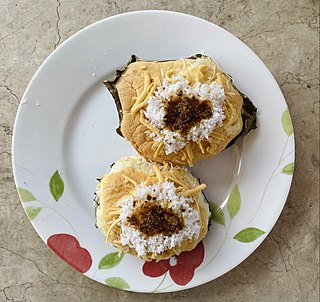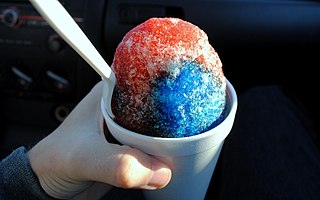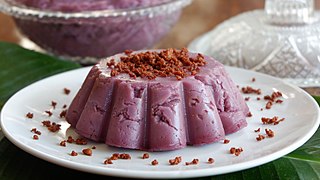
Filipino cuisine is composed of the cuisines of more than a hundred distinct ethnolinguistic groups found throughout the Philippine archipelago. A majority of mainstream Filipino dishes that compose Filipino cuisine are from the food traditions of various ethnolinguistic groups and tribes of the archipelago, including the Ilocano, Pangasinan, Kapampangan, Tagalog, Bicolano, Visayan, Chavacano and Maranao ethnolinguistic groups. The dishes associated with these groups evolved over the centuries from a largely indigenous base shared with maritime Southeast Asia with varied influences from Chinese, Spanish and American cuisines, in line with the major waves of influence that had enriched the cultures of the archipelago and adapted using indigenous ingredients to meet local preferences.

Halo-halo, also spelled haluhalo, Tagalog for "mixed", is a popular cold dessert in the Philippines made up of crushed ice, evaporated milk or coconut milk, and various ingredients including ube jam, sweetened kidney beans or garbanzo beans, coconut strips, sago, gulaman (agar), pinipig, boiled taro or soft yams in cubes, flan, slices or portions of fruit preserves and other root crop preserves. The dessert is topped with a scoop of ube ice cream. It is usually prepared in a tall clear glass and served with a long spoon. Halo-halo is considered to be the unofficial national dessert of the Philippines.

Bibingka commonly refers to a type of baked rice cake from the Philippines that is traditionally cooked in a terracotta oven lined with banana leaves and is usually eaten for breakfast or as merienda especially during the Christmas season.

Shaved ice is a large family of ice-based desserts made of fine shavings of ice or finely crushed ice and sweet condiments or syrups. Usually, the syrup is added after the ice has been frozen and shaved—typically at the point of sale; however, flavoring can also be added before freezing. The dessert is consumed worldwide in various forms and ways. Shaved ice can also be mixed with large quantities of liquid to produce shaved ice drinks.
Maíz con hielo is a shaved ice dessert from the Philippines made with boiled corn kernels, sugar, and milk.

Buko pie, sometimes anglicized as coconut pie, is a traditional Filipino baked young coconut (malauhog) custard pie. It is considered a specialty in the city of Los Baños, Laguna located on the island of Luzon.

Kalamay, is a sticky sweet delicacy that is popular in many regions of the Philippines. It is made of coconut milk, brown sugar, and ground glutinous rice. It can also be flavored with margarine, peanut butter, or vanilla. Kalamay can be eaten alone but is usually used as a sweetener for a number of Filipino desserts and beverages. It is related to the Chamorro dessert called Kalamai.

Sorbetes is a traditional ice cream originating from the Philippines and uniquely characterized by the use of coconut milk and/or carabao milk. Often pejoratively called "dirty ice cream", it is distinct from the similarly named sorbet and sherbet. It is traditionally peddled in colorful wooden pushcarts by street vendors called "sorbeteros". It is served in various flavors in small wafer or sugar cones and more recently, as a pandesal bread ice cream sandwich.

Benegnet is a Visayan dessert soup from the central Philippines. The dish is traditionally made with glutinous rice cooked in coconut milk with various slices of sabá bananas, taro, ube, and sweet potato, among other ingredients. It is comparable to various dessert guinataán dishes found in other regions such as bilo-bilo. Among the Visayan people, the dish is traditionally served during Good Friday of Holy Week.

Es doger is an Indonesian coconut milk-based shaved ice beverage with pinkish color often served as a dessert. It is a specialty of Bandung, West Java. The main, or base, part is sugared sweet coconut milk-based ice in pink syrup, served with pacar cina merah delima, avocado, cassava tapai, ketan hitam tapai, jackfruit, diced bread and condensed milk. The condensed milk can be plain (white), or chocolate flavoured. Es doger gains its pinkish color from rozen (rose) syrup, cocopandan syrup, or pink food coloring. Es doger is commonly sold by travelling vendor carts in major Indonesian cities, mainly in Bandung, Jakarta, Malang and Surabaya.

Ube halaya or halayang ube is a Philippine dessert made from boiled and mashed purple yam. Ube halaya is the main base in ube/purple yam flavored-pastries and ice cream. It can also be incorporated in other desserts such as halo-halo. It is also commonly anglicized as ube jam, or called by its original native name, nilupak na ube.

Samalamig, also known as palamig, is a collective term for various Filipino sweet chilled beverages that usually include jelly-like ingredients. They come in various flavors, and are commonly sold by street vendors as refreshments. Typical ingredients of the drinks include gulaman (agar), sago pearls, kaong, tapioca pearls, nata de coco, and coconut. They are usually anglicized as pearl coolers or pearl and jelly coolers.

Minatamis na saging is a Filipino dessert made with chopped saba bananas cooked in a sweet syrup (arnibal) made with muscovado sugar and water. Some recipes also add a little bit of salt and pandan leaf or vanilla extract. Other ingredients can also be added like sweet potato, sago, or other fruits like jackfruit. It can be eaten on its own or added as an ingredient to other desserts. Adding the dessert over milk and shaved ice also results in another dessert known as saba con yelo.
Ice buko, also known as buko ice candy or coconut popsicle, is a Filipino frozen dessert made from condensed milk, young coconut (buko) strips, and coconut water. It is basically a frozen version of the buko salad. They can be sold on popsicle sticks or in plastic bags as ice candy. They commonly include other ingredients like peanuts, pinipig, macapuno, pandan leaf extracts, various fruits, or sweetened mung beans. They are popular desserts during the summer and are commonly sold by sari-sari stores and sorbeteros.

Buko salad, usually anglicized as young coconut salad, is a Filipino fruit salad dessert made from strips of fresh young coconut (buko) with sweetened milk or cream and various other ingredients. It is one of the most popular and ubiquitous Filipino desserts served during celebrations and fiestas.

Iskrambol, also known as ice scramble, is a Filipino frozen dessert made from shaved ice with banana extract and evaporated milk with sugar It is then topped with a variety of ingredients including powdered milk, marshmallows, strawberry syrup, chocolate syrup, pinipig, tapioca pearls, and sprinkles, among others. The regular banana extract flavored dessert is characteristically dyed pink while other flavors may be dyed accordingly.

Avocado and milk in ice is a traditional Filipino dessert or beverage made from avocado in milk and sugar. It is preferably eaten cold. Ice are added, or it is partly frozen before consumption. The milk can also be excluded, mixing avocados directly with sugar. The avocados can also be mashed or puréed, which is usually called avocado milkshake or avocado smoothie. Sliced dessert bananas are sometimes added.
















